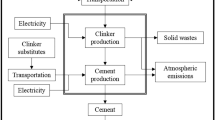Abstract
The cement industry is characterisedby intensive energy consumption throughout itsproduction stages which, together with the calcinationof its raw materials, accounts for significant amountsof greenhouse gases (GHG) emissions. In 1996, theBrazilian cement industry consumed 4.3% of the energyrequired by the industrial sector, contributing over22 Tg (Teragrams) of CO2. The prospects forgrowth in this sector in Brazil indicate risingdemands for fossil fuels, with a consequent upsurge inemissions. This article aims to present the prospectsfor energy conservation in the Brazilian cementindustry through to 2015, taking into account: theintroduction of new production technologies in thissector, the use of waste and low-grade fuels,cogeneration, the use of cementitious materials, andother measures, based on a technical and economicenergy demand simulation model. In all scenarios, wefound that is possible to significantly reduce energyconsumption and CO2 emissions for BrazilianCement Industry. Under the market potential scenarios,energy savings vary between 1562.0 to 1900.6 PJ(PetaJoules), with use of cementitious materialsaccounting for around 31% of this total. Fortechnical potential scenarios, use of cementitiousmaterials could represent 51% to 52% of totalachieved energy savings, between 2374.6 to 2803.4 PJ.
Similar content being viewed by others
References
Cahn, D., Greer,W., Mikols, E. and Moir, R.: 1997, 'Atmospheric CO2 and the US cement industry', World Cement 28, 63-66.
CEMIG [Companhia Energética de Minas Gerais]: 1992, Cogeração no setor cimenteiro. Conselho Estadual de Energia, Belo Horizonte, Brasil, Governo do Estado de Minas Gerais.
EIPPCB [European Integrated Pollution Prevention and Control Bureau]: 1999, Draft Reference Document on Best Available Techniques in the Cement and Lime Industries, Chapter 3, Seville. (http://www.eippcb.jrc.es).
Fonseca, M.A.S., Carmo, A.J.B. and Terada, O.A.: 1992, 'Consumo energético na indÚstria brasileira de cimento', in Seminário CEE/Brasil-Setores industriais intensivos em energia, São Paulo, Brasil, IPT/SP.
Hendricks, C.A., Worrell, E., Price, L., Martin, N. and Ozawa Meida, L.: 1999, Greenhouse Gases from Cement Production, prepared for the IEA Greenhouse Gas R&D Programme. Utrecht, The Netherlands, ECOFYS.
Marciano J.E. and Kihara, Y.: 1997, 'Looking Green', World Cement 27, April.
MME [Ministry of Mines and Energy]: 1999, Balanço Energético Nacional, Brasília, Brasil.
MME/FDTE: 1995, Balanço de Energia Útil-Modelo de Avaliação do Potential de Economia de Energia, Ministério das Minas e Energia, Brasília.
Rosa, L.P., Schaeffer, R. and Santos, M.A.: 1996, 'Emissions de Metano e dióxido de carbono de hidrelétricas comparadas às de termelétricas equivalentes', in Diagnóstico Ambiental e Energético das Hidrelétricas na Amazônia, Cadernos de Energia. Edição Especial do Centro de Estudos de Energia. ENERGE, Rio de Janeiro, Brasil.
Santi, A.M.M.: 1997, O Emprego de Resíduos como Combustíveis Complementares na Produção de Cement, na Perspectiva da Energia, Sociedade e Meio Ambiente, Estudo de caso: Minas Gerais no period 1980-1997. Tese de MSc. Universidade Estadual de Campinas, Campinas, Brasil.
Schaeffer, R., Machado, G.V., Costa, M.M. and AraÚjo, M.A.: 1998, 'Estimativa do potential de conservação de energia elétrica pelo lado da demanda no Brasil', Projeto PROCEL/COPPETEC, Programa PNUD BRA/93/032, Relatório Final, Rio de Janeiro, Brasil.
Silva, R.J. and Nebra S.A.: 1993, 'O uso eficiente da energia com as novas tecnologias de produção do cimento', in Anais do VI CBE. I Seminário Latino Americano de Energia, Rio de Janeiro, Brasil.
Silva, R.J.: 1994, Análise Energética de Plantas de Produção de Cimento Portland, D.Sc. Thesis. Universidade Estadual de Campinas, Campinas, Brasil.
Silva, R.J. and Nebra, S.A.: 1996, 'Thermoeconomic comparative analysis of different process of cement production', in Proceedings of ECOS'96. Efficiency, costs, optimization, simulation and environmental aspects of Energy Systems, Stockholm, Sweden, Royal Institute of Technology.
SNIC [Sindicato Nacional da IndÚstria do Cimento]: 1996, Relatório Anual do Sindicato Nacional da IndÚstria de Cimento, Rio de Janeiro, Brasil.
Soares, J.B.: 1998, Potential de Conservação de Energia e de Mitigação das Emissões de Gases de Efeito Estufa para a IndÚstria Brasileira de Cimento Portland até 2015, MSc. Thesis. Rio de Janeiro, Brasil, Federal University of Rio de Janeiro.
Tolmasquim, M.T. and Szklo, A.S. (eds): 1999, A energia no Brasil na Virada do Milênio-A Matriz Energética do Brasil: 1998-2010. Rio de Janeiro, Brasil (in press).
WEC [World Energy Council]: 1995, Energy efficiency improvement utilising high energy. An assessment of energy use in industry and buildings. Report & Case Studies. Prepared by M.D.
Levine, E. Worrell, N. Martin and L. Price, United Kingdom, pp. 143-151.
Von Buzzi, S. and Sassone, G.: 1993, Optimierung des Klinkerkühlerbetriebs. (Optimization of Clinker cooler operation), Revised Text of a lecture to the VDZ Congress'93. Düsseldorf, Germany.
Author information
Authors and Affiliations
Rights and permissions
About this article
Cite this article
Borghetti Soares, J., Tiomno Tolmasquim, M. Energy efficiency and reduction of Co2 emissions through 2015: The Brazilian cement industry. Mitigation and Adaptation Strategies for Global Change 5, 297–318 (2000). https://doi.org/10.1023/A:1009621514625
Issue Date:
DOI: https://doi.org/10.1023/A:1009621514625




